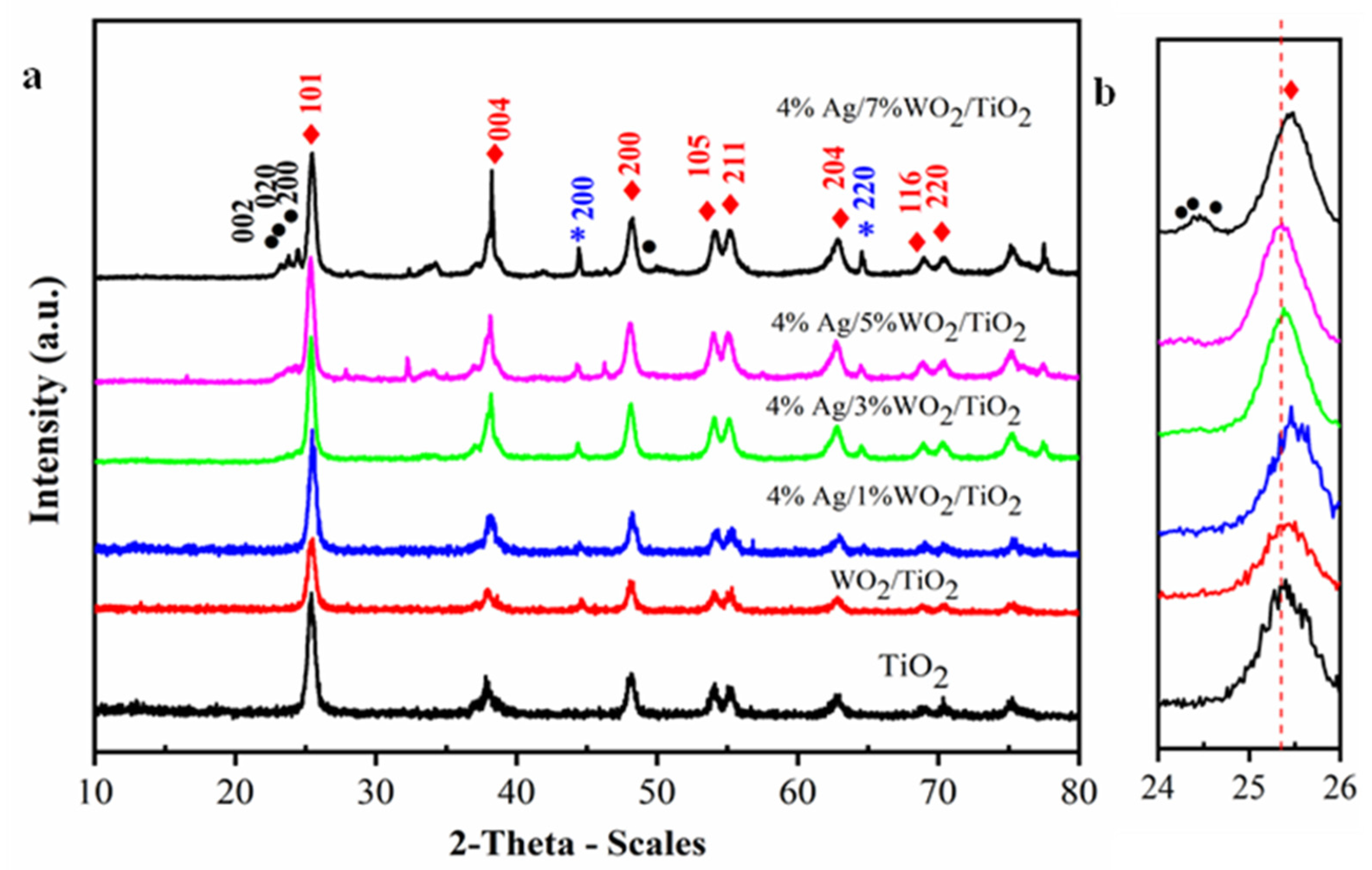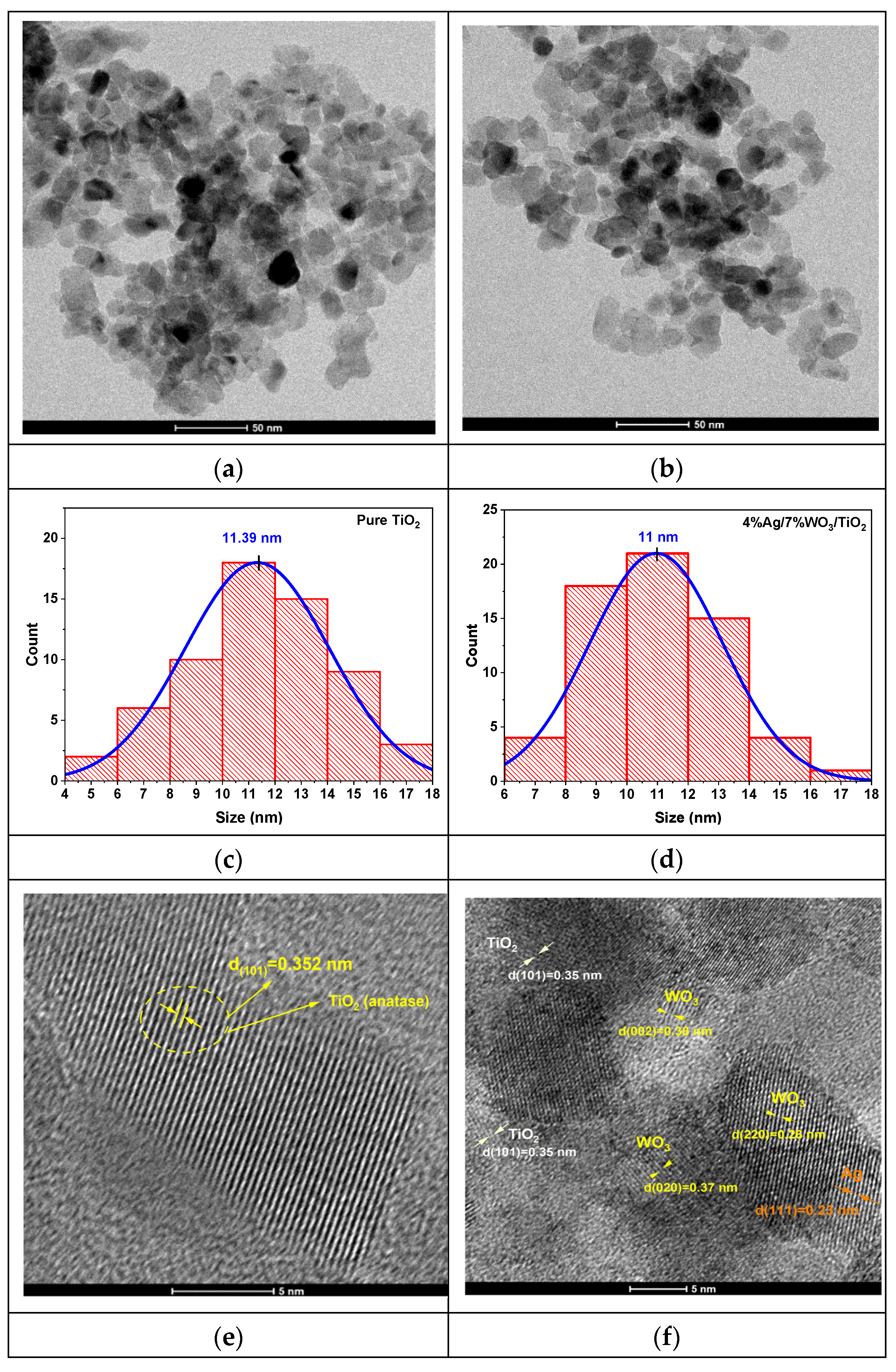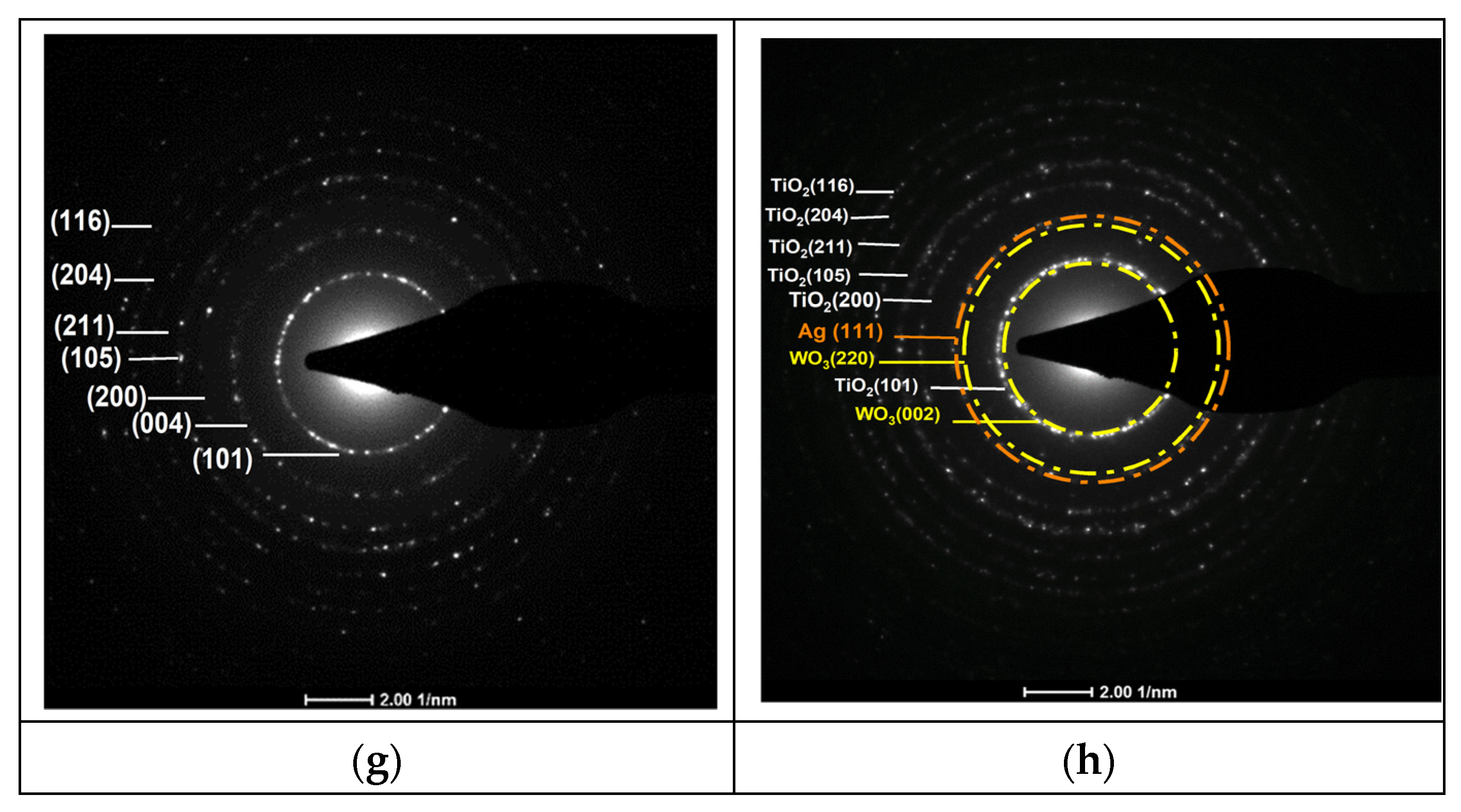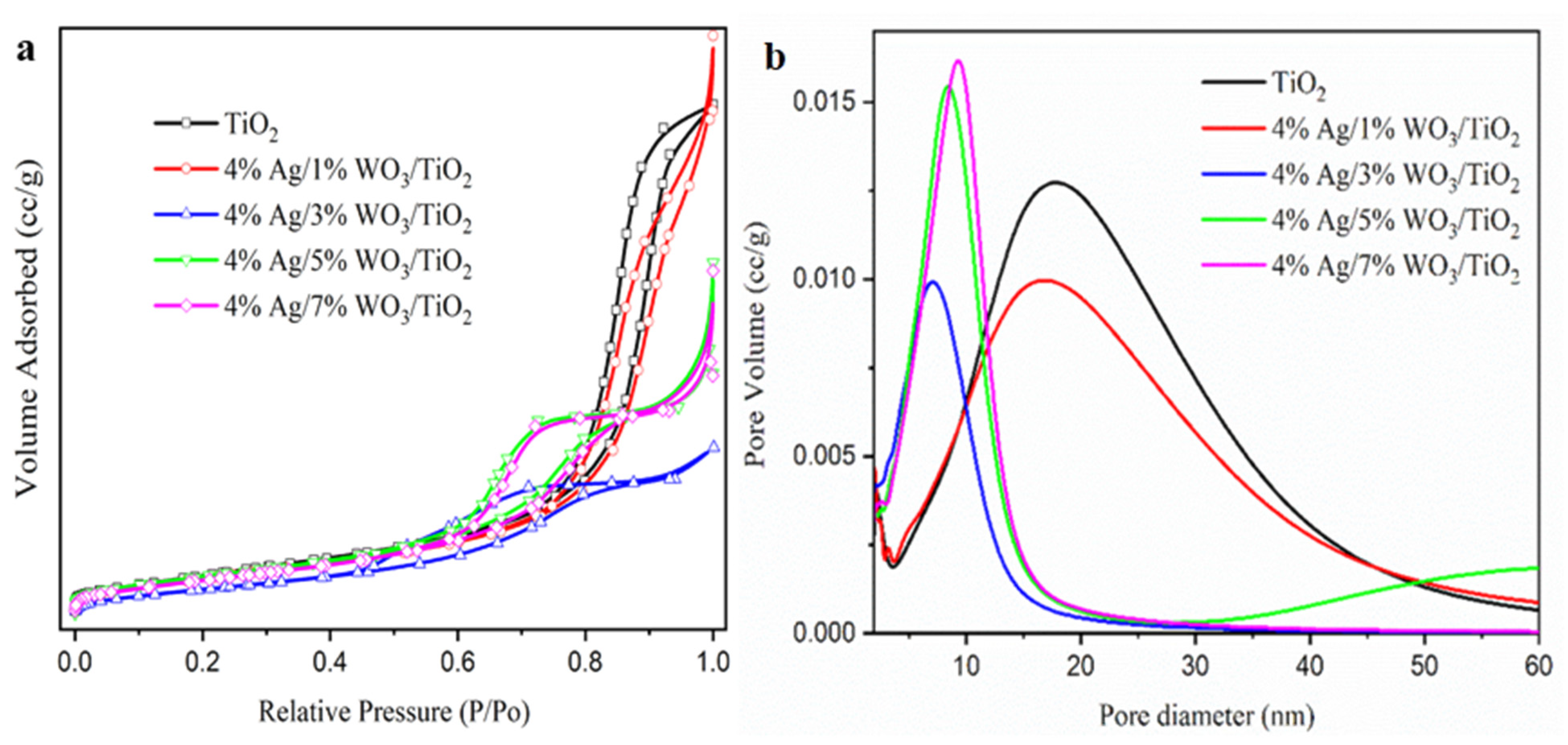Enhancement Study of the Photoactivity of TiO2 Photocatalysts during the Increase of the WO3 Ratio in the Presence of Ag Metal
Abstract
1. Introduction
2. Result and Discussion
3. Materials and Methods
3.1. Materials
3.2. Methods
3.2.1. Synthesis of Titanium Nanoparticle TiO2 (NPs)
3.2.2. Synthesis of (1, 3, 5 and 7% WO3)/TiO2 Nanocomposite
3.2.3. Synthesis of 4%Ag/x%WO3/TiO2
3.3. Characterization Techniques
4. Conclusions
Supplementary Materials
Author Contributions
Funding
Data Availability Statement
Acknowledgments
Conflicts of Interest
References
- Lai, C.W. WO3-TiO2 Nanocomposite and Its Applications: A Review. Nano Hybrids Compos. 2018, 20, 1–26. [Google Scholar] [CrossRef]
- Khan, A.; Gaikwad, M.A.; Kim, J.H.; Kadam, A. An Overview and Experimental analysis of WO3/TiO2 Composite with Enhanced Electrochromic Properties for Smart Windows Application. Tungsten 2024, 6, 732–747. [Google Scholar] [CrossRef]
- Folli, A.; Bloh, J.Z.; Strøm, M.; Pilegaard Madsen, T.; Henriksen, T.; Macphee, D.E. Efficiency of Solar-Light-Driven TiO2 Photocatalysis at Different Latitudes and Seasons. Where and When Does TiO2 Really Work? J. Phys. Chem. Lett. 2014, 5, 830–832. [Google Scholar] [CrossRef] [PubMed]
- Kathirvelan, J.; Vijayaraghavan, R.; Thomas, A. Ethylene Detection Using TiO2–WO3 Composite Sensor for Fruit Ripening Applications. Sens. Rev. 2017, 37, 147–154. [Google Scholar] [CrossRef]
- Serga, V.; Burve, R.; Krumina, A.; Pankratova, V.; Popov, A.I.; Pankratov, V. Study of Phase Composition, Photocatalytic Activity, and Photoluminescence of TiO2 with Eu Additive Produced by the Extraction-Pyrolytic Method. J. Mater. Res. Technol. 2021, 13, 2350–2360. [Google Scholar] [CrossRef]
- Matějová, L.; Kočí, K.; Reli, M.; Čapek, L.; Hospodková, A.; Peikertová, P.; Matěj, Z.; Obalová, L.; Wach, A.; Kuśtrowski, P.; et al. Preparation, Characterization and Photocatalytic Properties of Cerium Doped TiO2: On the Effect of Ce Loading on the Photocatalytic Reduction of Carbon Dioxide. Appl. Catal. B Environ. 2014, 152–153, 172–183. [Google Scholar] [CrossRef]
- Li, T.; Luo, S.; Luo, Y.; Yang, L. Ag/AgI Nanoparticles Decorated WO3/TiO2 Nanotubes with Enhanced Visible Light Photocatalytic Activity. Mater. Lett. 2016, 180, 130–134. [Google Scholar] [CrossRef]
- Hirakawa, T.; Kamat, P. V Photoinduced Electron Storage and Surface Plasmon Modulation in Ag@ TiO2 Clusters. Langmuir 2004, 20, 5645–5647. [Google Scholar] [CrossRef]
- Jakob, M.; Levanon, H.; Kamat, P. V Charge Distribution between UV-Irradiated TiO2 and Gold Nanoparticles: Determination of Shift in the Fermi Level. Nano Lett. 2003, 3, 353–358. [Google Scholar] [CrossRef]
- Wang, N.; Xu, Y.; Zhu, L.; Shen, X.; Tang, H. Reconsideration to the Deactivation of TiO2 Catalyst during Simultaneous Photocatalytic Reduction of Cr (VI) and Oxidation of Salicylic Acid. J. Photochem. Photobiol. A Chem. 2009, 201, 121–127. [Google Scholar] [CrossRef]
- Vinodgopal, K.; Bedja, I.; Kamat, P. V Nanostructured Semiconductor Films for Photocatalysis. Photoelectrochemical Behavior of SnO2/TiO2 Composite Systems and Its Role in Photocatalytic Degradation of a Textile Azo Dye. Chem. Mater. 1996, 8, 2180–2187. [Google Scholar] [CrossRef]
- He, Y.; Wu, Z.; Fu, L.; Li, C.; Miao, Y.; Cao, L.; Fan, H.; Zou, B. Photochromism and Size Effect of WO3 and WO3−TiO2 Aqueous Sol. Chem. Mater. 2003, 15, 4039–4045. [Google Scholar] [CrossRef]
- Archana, P.S.; Gupta, A.; Yusoff, M.M.; Jose, R. Tungsten Doped Titanium Dioxide Nanowires for High Efficiency Dye-Sensitized Solar Cells. Phys. Chem. Chem. Phys. 2014, 16, 7448–7454. [Google Scholar] [CrossRef]
- Yu, X.-F.; Wu, N.-Z.; Huang, H.-Z.; Xie, Y.-C.; Tang, Y.-Q. A Study on the Monolayer Dispersion of Tungsten Oxide on Anatase. J. Mater. Chem. 2001, 11, 3337–3342. [Google Scholar] [CrossRef]
- Pan, J.H.; Lee, W.I. Preparation of Highly Ordered Cubic Mesoporous WO3/TiO2 Films and Their Photocatalytic Properties. Chem. Mater. 2006, 18, 847–853. [Google Scholar] [CrossRef]
- Reyes-Gil, K.R.; Robinson, D.B. WO3-Enhanced TiO2 Nanotube Photoanodes for Solar Water Splitting with Simultaneous Wastewater Treatment. ACS Appl. Mater. Interfaces 2013, 5, 12400–12410. [Google Scholar] [CrossRef]
- Reyes-Gil, K.R.; Stephens, Z.D.; Stavila, V.; Robinson, D.B. Composite WO3/TiO2 Nanostructures for High Electrochromic Activity. ACS Appl. Mater. Interfaces 2015, 7, 2202–2213. [Google Scholar] [CrossRef]
- Vidyadharan, B.; Archana, P.S.; Ismail, J.; Yusoff, M.M.; Jose, R. Improved Supercapacitive Charge Storage in Electrospun Niobium Doped Titania Nanowires. RSC Adv. 2015, 5, 50087–50097. [Google Scholar] [CrossRef]
- Krishnan, S.G.; Archana, P.S.; Vidyadharan, B.; Misnon, I.I.; Vijayan, B.L.; Nair, V.M.; Gupta, A.; Jose, R. Modification of Capacitive Charge Storage of TiO2 with Nickel Doping. J. Alloys Compd. 2016, 684, 328–334. [Google Scholar] [CrossRef]
- Chen, D.; Cheng, Y.; Zhou, N.; Chen, P.; Wang, Y.; Li, K.; Huo, S.; Cheng, P.; Peng, P.; Zhang, R. Photocatalytic Degradation of Organic Pollutants Using TiO2-Based Photocatalysts: A Review. J. Clean. Prod. 2020, 268, 121725. [Google Scholar] [CrossRef]
- Chen, D.; Li, T.; Chen, Q.; Gao, J.; Fan, B.; Li, J.; Li, X.; Zhang, R.; Sun, J.; Gao, L. Hierarchically Plasmonic Photocatalysts of Ag/AgCl Nanocrystals Coupled with Single-Crystalline WO3 Nanoplates. Nanoscale 2012, 4, 5431–5439. [Google Scholar] [CrossRef] [PubMed]
- Li, Y.; Wu, W.; Dai, P.; Zhang, L.; Sun, Z.; Li, G.; Wu, M.; Chen, X.; Chen, C. WO3 and Ag Nanoparticle Co-Sensitized TiO2 Nanowires: Preparation and the Enhancement of Photocatalytic Activity. RSC Adv. 2014, 4, 23831–23837. [Google Scholar] [CrossRef]
- Xu, J.Y.; Wen, C.; Jia, L.M.; Xiao, C.F. Ag/WO3-Codoped TiO2 Nanoparticles: Relation between Structure, Sorption, and Photocatalytic Activity. In Proceedings of the Second International Conference on Smart Materials and Nanotechnology in Engineering, Weihai, China, 8–11 July 2009; Volume 7493, pp. 1522–1528. [Google Scholar]
- Basumatary, B.; Basumatary, R.; Ramchiary, A.; Konwar, D. Evaluation of Ag@TiO2/WO3 Heterojunction Photocatalyst for Enhanced Photocatalytic Activity towards Methylene Blue Degradation. Chemosphere 2022, 286, 131848. [Google Scholar] [CrossRef] [PubMed]
- Mineo, G.; Bruno, E.; Mirabella, S. Advances in WO3-Based Supercapacitors: State-of-the-Art Research and Future Perspectives. Nanomaterials 2023, 13, 1418. [Google Scholar] [CrossRef]
- Samuel, O.; Othman, M.H.D.; Kamaludin, R.; Sinsamphanh, O.; Abdullah, H.; Puteh, M.H.; Kurniawan, T.A. WO3–Based Photocatalysts: A Review on Synthesis, Performance Enhancement and Photocatalytic Memory for Environmental Applications. Ceram. Int. 2022, 48, 5845–5875. [Google Scholar] [CrossRef]
- Bahadur, J.; Agrawal, S.; Parveen, A.; Jawad, A.; Ashraf, S.S.Z.; Ghalib, R.M. Micro-Structural, Optical and Dielectric Properties of Ag Doped TiO2 Synthesized by Sol–Gel Method. Mater. Focus 2015, 4, 134–141. [Google Scholar] [CrossRef]
- Abdul Gafoor, A.K.; Musthafa, M.M.; Pradyumnan, P.P. AC Conductivity and Diffuse Reflectance Studies of Ag-TiO2 Nanoparticles. J. Electron. Mater. 2012, 41, 2387–2392. [Google Scholar] [CrossRef]
- Liu, S.; Guo, E.; Yin, L. Tailored Visible-Light Driven Anatase TiO2 Photocatalysts Based on Controllable Metal Ion Doping and Ordered Mesoporous Structure. J. Mater. Chem. 2012, 22, 5031. [Google Scholar] [CrossRef]
- Ismail, A.A.; Abdelfattah, I.; Helal, A.; Al-Sayari, S.A.; Robben, L.; Bahnemann, D.W. Ease Synthesis of Mesoporous WO3–TiO2 Nanocomposites with Enhanced Photocatalytic Performance for Photodegradation of Herbicide Imazapyr under Visible Light and UV Illumination. J. Hazard. Mater. 2016, 307, 43–54. [Google Scholar] [CrossRef]
- Wahba, M.A.; Yakout, S.M.; Sheta, S.M.; Helal, A.; El-Sheikh, S.M. Robust Ferromagnetic V0.05-XCoxZn0.95O (x = 0.01, 0.02, 0.03, 0.04, 0.05) Nano-Compounds: New Dilute Magnetic-Semiconductors with Tailored Optical Activity. J. Alloys Compd. 2024, 1003, 175503. [Google Scholar] [CrossRef]
- Ernawati, L.; Wahyuono, R.A.; Muhammad, A.A.; Nurislam Sutanto, A.R.; Maharsih, I.K.; Widiastuti, N.; Widiyandari, H. Mesoporous WO3/TiO2 Nanocomposites Photocatalyst for Rapid Degradation of Methylene Blue in Aqueous Medium. Int. J. Eng. 2019, 32, 1345–1352. [Google Scholar] [CrossRef]
- Araújo, E.S.; Leão, V.N.S. TiO2/WO3 Heterogeneous Structures Prepared by Electrospinning and Sintering Steps: Characterization and Analysis of the Impedance Variation to Humidity. J. Adv. Ceram. 2019, 8, 238–246. [Google Scholar] [CrossRef]
- Sathasivam, S.; Bhachu, D.S.; Lu, Y.; Chadwick, N.; Althabaiti, S.A.; Alyoubi, A.O.; Basahel, S.N.; Carmalt, C.J.; Parkin, I.P. Tungsten Doped TiO2 with Enhanced Photocatalytic and Optoelectrical Properties via Aerosol Assisted Chemical Vapor Deposition. Sci. Rep. 2015, 5, 10952. [Google Scholar] [CrossRef] [PubMed]
- Ren, R.; Wen, Z.; Cui, S.; Hou, Y.; Guo, X.; Chen, J. Controllable Synthesis and Tunable Photocatalytic Properties of Ti3+-Doped TiO2. Sci. Rep. 2015, 5, 10714. [Google Scholar] [CrossRef] [PubMed]
- Gao, J.; Yang, W.; Fang, C.; Liang, J.; Cheng, T.; Li, P.; Guo, X.; Jung, Y.; Wang, Y.; Dong, X. Facile Synthesis of TiO2/WO3 Nanocomposites and the Electrochemical Lithiation/Delithiation Activity. J. Mater. Sci. 2021, 56, 14505–14517. [Google Scholar] [CrossRef]
- Ramírez-Ortega, D.; Guerrero-Araque, D.; Acevedo-Peña, P.; Lartundo-Rojas, L.; Zanella, R. Effect of Pd and Cu Co-Catalyst on the Charge Carrier Trapping, Recombination and Transfer during Photocatalytic Hydrogen Evolution over WO3–TiO2 Heterojunction. J. Mater. Sci. 2020, 55, 16641–16658. [Google Scholar] [CrossRef]
- Fang, H.; Cao, X.; Yu, J.; Lv, X.; Yang, N.; Wang, T.; Jiang, W. Preparation of the All-Solid-State Z-Scheme WO3/Ag/AgCl Film on Glass Accelerating the Photodegradation of Pollutants under Visible Light. J. Mater. Sci. 2019, 54, 286–301. [Google Scholar] [CrossRef]
- Roumaih, K.; Ismail, S.M.; Labib, S.; Helal, A. Structural, Magnetic, and Optical Properties of ZnFe2O4/RO (RO = CdO, NiO, Ga2O3, SnO2, and TiO2) Nanocomposites. J. Mater. Sci. 2023, 58, 7948–7967. [Google Scholar] [CrossRef]
- Li, Y.; Chen, L.; Guo, Y.; Sun, X.; Wei, Y. Preparation and Characterization of WO3/TiO2 Hollow Microsphere Composites with Catalytic Activity in Dark. Chem. Eng. J. 2012, 181, 734–739. [Google Scholar] [CrossRef]
- Sajjad, A.K.L.; Shamaila, S.; Tian, B.; Chen, F.; Zhang, J. One Step Activation of WOx/TiO2 Nanocomposites with Enhanced Photocatalytic Activity. Appl. Catal. B Environ. 2009, 91, 397–405. [Google Scholar] [CrossRef]
- Bai, S.; Liu, H.; Sun, J.; Tian, Y.; Chen, S.; Song, J.; Luo, R.; Li, D.; Chen, A.; Liu, C.-C. Improvement of TiO2 Photocatalytic Properties under Visible Light by WO3/TiO2 and MoO3/TiO2 Composites. Appl. Surf. Sci. 2015, 338, 61–68. [Google Scholar] [CrossRef]
- Tryba, B.; Piszcz, M.; Morawski, A.W. Photocatalytic Activity of TiO2-WO3 Composites. Int. J. Photoenergy 2009, 2009, 1–7. [Google Scholar] [CrossRef]
- Kubelka, P.; Munk, F. A Contribution to the Optics of Pigments. Z. Technol. Phys. 1931, 12, 593–599. [Google Scholar]
- Tauc, J.; Grigorovici, R.; Vancu, A. Optical Properties and Electronic Structure of Amorphous Germanium. Phys. Status Solidi B 1966, 15, 627–637. [Google Scholar] [CrossRef]
- Zhang, L.; Li, Y.; Zhang, Q.; Wang, H. Hierarchical Nanostructure of WO3 Nanorods on TiO2 Nanofibers and the Enhanced Visible Light Photocatalytic Activity for Degradation of Organic Pollutants. CrystEngComm 2013, 15, 5986. [Google Scholar] [CrossRef]
- Ha, J.-H.; Muralidharan, P.; Kim, D.K. Hydrothermal Synthesis and Characterization of Self-Assembled h-WO3 Nanowires/Nanorods Using EDTA Salts. J. Alloys Compd. 2009, 475, 446–451. [Google Scholar] [CrossRef]
- de Castro, I.A.; Avansi, W.; Ribeiro, C. WO3/TiO2 Heterostructures Tailored by the Oriented Attachment Mechanism: Insights from Their Photocatalytic Properties. CrystEngComm 2014, 16, 1514–1524. [Google Scholar] [CrossRef]
- Helal, A.; Yu, J.; Ghanem, M.A.; Labib, A.A.; El-Sheikh, S.M. Boosting the Photocatalytic Activity of Bismuth Vanadate (BiVO4) via Optimization of the Internal Polarization. J. Mol. Struct. 2024, 1312, 138553. [Google Scholar] [CrossRef]
- Lai, C.W.; Sreekantan, S. Incorporation of WO3 Species into TiO2 Nanotubes via Wet Impregnation and Their Water-Splitting Performance. Electrochim. Acta 2013, 87, 294–302. [Google Scholar] [CrossRef]
- Khan, S.B.; Hou, M.; Shuang, S.; Zhang, Z. Morphological Influence of TiO2 Nanostructures (Nanozigzag, Nanohelics and Nanorod) on Photocatalytic Degradation of Organic Dyes. Appl. Surf. Sci. 2017, 400, 184–193. [Google Scholar] [CrossRef]
- Mohamed, M.M.; Ghanem, M.A.; Khairy, M.; Naguib, E.; Alotaibi, N.H. Zinc Oxide Incorporated Carbon Nanotubes or Graphene Oxide Nanohybrids for Enhanced Sonophotocatalytic Degradation of Methylene Blue Dye. Appl. Surf. Sci. 2019, 487, 539–549. [Google Scholar] [CrossRef]
- Widiyandari, H.; Nashir, M.; Parasdila, H.; Almas, K.F.; Suryana, R. Ag-TiO2 for Efficient Methylene Blue Photodegradation Under Visible Light Irradiation. Bull. Chem. React. Eng. Catal. 2023, 18, 593–603. [Google Scholar] [CrossRef]
- Dong, P.; Yang, B.; Liu, C.; Xu, F.; Xi, X.; Hou, G.; Shao, R. Highly Enhanced Photocatalytic Activity of WO3 Thin Films Loaded with Pt-Ag Bimetallic Alloy Nanoparticles. RSC Adv. 2017, 7, 947–956. [Google Scholar] [CrossRef]
- Liu, Q.; Zhou, B.; Xu, M.; Mao, G. Integration of Nanosized ZIF-8 Particles onto Mesoporous TiO2 Nanobeads for Enhanced Photocatalytic Activity. RSC Adv. 2017, 7, 8004–8010. [Google Scholar] [CrossRef]
- Helal, A.; Salem, A.M.S.; El-Hout, S.I. Highly Efficient Visible Light Photoreduction of Cr(VI) via PANI/Bi2S3 Z-Scheme Behavior. J. Photochem. Photobiol. A Chem. 2024, 447, 115232. [Google Scholar] [CrossRef]









| Sample | D (nm) | δ | ε |
|---|---|---|---|
| Pure TiO2 | 17.01 | 3.45 × 10−3 | 9.27 × 10−3 |
| WO3/TiO2 | 15.77 | 3.50 × 10−3 | 9.14 × 10−3 |
| 4%Ag/1%WO3/TiO2 | 15.94 | 3.93 × 10−3 | 9.90 × 10−3 |
| 4%Ag/3%WO3/TiO2 | 15.91 | 3.94 × 10−3 | 9.89 × 10−3 |
| 4%Ag/5%WO3/TiO2 | 14.50 | 4.75 × 10−3 | 10.8 × 10−3 |
| 4%Ag/7%WO3/TiO2 | 13.98 | 5.11 × 10−3 | 11.2 × 10−3 |
| Bandgap (eV) | SA (m2/g) | PV [cm3 g−1] | Pd [nm] | |
|---|---|---|---|---|
| Pure TiO2 | 3.2 | 66.21 | 0.2624 | 18.983 |
| 4%Ag/1%WO3/TiO2 | 2.72 | 62.56 | 0.2604 | 15.854 |
| 4%Ag/3%WO3/TiO2 | 2.40 | 48.98 | 0.0795 | 5.9162 |
| 4%Ag/5%WO3/TiO2 | 2.69 | 59.93 | 0.1806 | 12.003 |
| 4%Ag/7%WO3/TiO2 | 2.82 | 63.08 | 0.1852 | 11.475 |
Disclaimer/Publisher’s Note: The statements, opinions and data contained in all publications are solely those of the individual author(s) and contributor(s) and not of MDPI and/or the editor(s). MDPI and/or the editor(s) disclaim responsibility for any injury to people or property resulting from any ideas, methods, instructions or products referred to in the content. |
© 2024 by the authors. Licensee MDPI, Basel, Switzerland. This article is an open access article distributed under the terms and conditions of the Creative Commons Attribution (CC BY) license (https://creativecommons.org/licenses/by/4.0/).
Share and Cite
Aldirham, S.H.; Helal, A.; Shkir, M.; Sayed, M.A.; Ali, A.M. Enhancement Study of the Photoactivity of TiO2 Photocatalysts during the Increase of the WO3 Ratio in the Presence of Ag Metal. Catalysts 2024, 14, 633. https://doi.org/10.3390/catal14090633
Aldirham SH, Helal A, Shkir M, Sayed MA, Ali AM. Enhancement Study of the Photoactivity of TiO2 Photocatalysts during the Increase of the WO3 Ratio in the Presence of Ag Metal. Catalysts. 2024; 14(9):633. https://doi.org/10.3390/catal14090633
Chicago/Turabian StyleAldirham, Sharah H., Ahmed Helal, Mohd Shkir, M. A. Sayed, and Atif Mossad Ali. 2024. "Enhancement Study of the Photoactivity of TiO2 Photocatalysts during the Increase of the WO3 Ratio in the Presence of Ag Metal" Catalysts 14, no. 9: 633. https://doi.org/10.3390/catal14090633
APA StyleAldirham, S. H., Helal, A., Shkir, M., Sayed, M. A., & Ali, A. M. (2024). Enhancement Study of the Photoactivity of TiO2 Photocatalysts during the Increase of the WO3 Ratio in the Presence of Ag Metal. Catalysts, 14(9), 633. https://doi.org/10.3390/catal14090633







